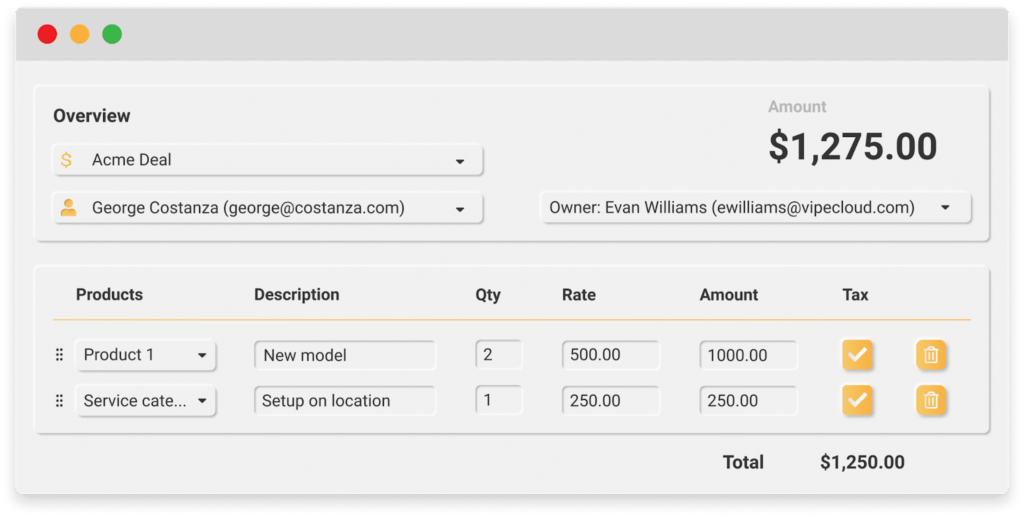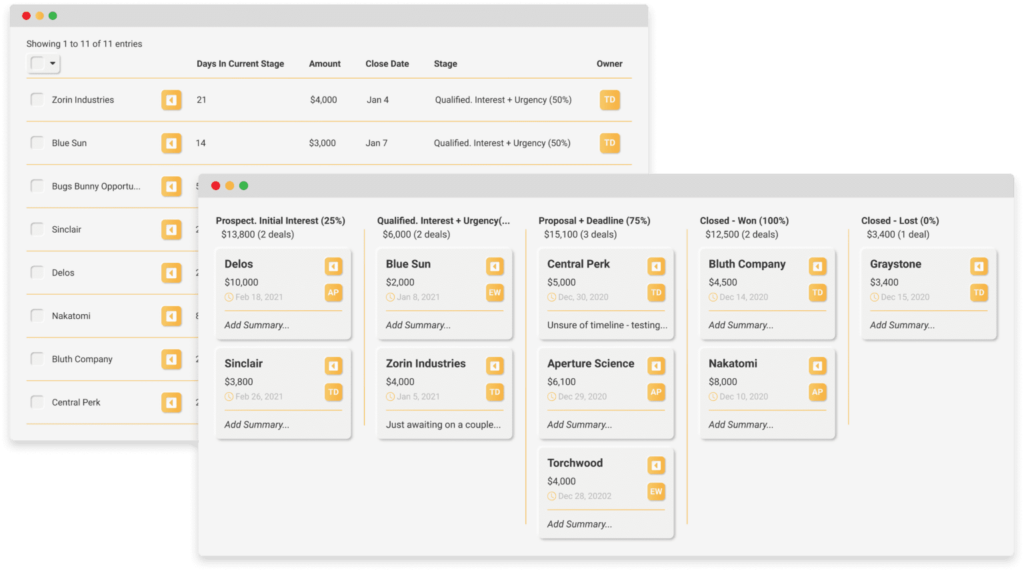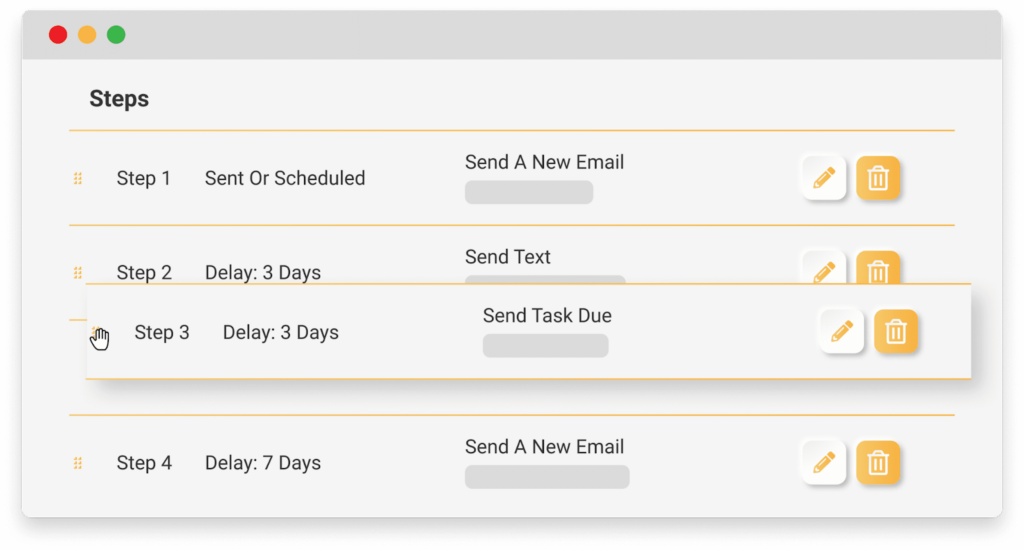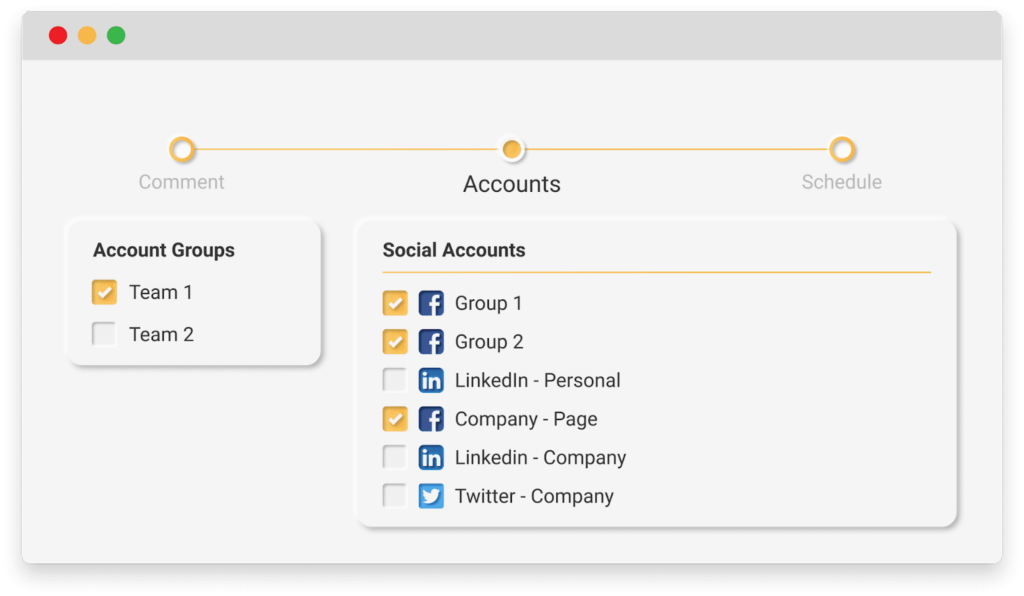Last updated on August 7th, 2023

Refining your roofing company’s sales process is one of the most critical revenue-generating activities you can do.
Without a practical approach to selling, you could miss out on high-value clients, not to mention repeat business.
So we put together this guide to help your sales process evolve so you can increase your roofing sales.
Table of Contents:
- Why Is Upgrading Your Roofing Sales Process A No-Brainer?
- 19 Tips Roofing Companies Can Apply To Improve Selling
- Frequently Asked Questions About Roof Sales
- Skyrocket Your Roofing Sales Process With VipeCloud

VipeCloud is the only Automation tool your small business needs to
be the hero to your customers.
With Email, Texting, Social, Suites, Chat, Stories, Video Email & Sign Up Forms fully built-in, we provide you with the perfect platform to grow your business.
15 Day Free Trial – Get started risk free. No CC needed.
Why Is Upgrading Your Roofing Sales Process A No-Brainer?
1. Increase Revenue Through A Higher Conversion Rate
Increasing the number of people converting into customers is a quick way to see revenue spikes.
If your marketing brings you enough leads each month, a better sales process brings a night-and-day difference to your top line.
Making more from your opportunities means more capital to reinvest in different areas of your roofing company (new hires, more roofing tools, technology, more marketing, etc.)
2. Higher Customer Lifetime Value
82% of companies agree that customer retention is cheaper than acquisition.

Satisfied customers stick with you longer, which usually means they become more valuable over time.
A proven sales process includes what you do to keep your customers longer.
Excellent service is one way to keep customers, but offering incentives to keep being a customer works too.
The longer you keep customers on average, the more you can invest in marketing and other business areas compared to competitors.
And the best part?
If your profit margins are higher than the industry average, you’ll have a better bottom line long term.
3. More Referrals
Referred customers have a 37% higher retention rate than customers gained through other marketing channels.
Referrals are crucial because it’s the easiest way to win new customers.
The sales process doesn’t end after someone decides to get a roof replacement from your company.
There’s still room to leverage that customer to help you bring more customers.
When you pair this with an incentive, each satisfied customer becomes even more valuable.
Because not only does a satisfied customer’s lifetime value increase but so does the likelihood of them referring your business.
You get referrals this way, and these referrals are people you didn’t have to spend money to acquire.
4. Close Roofing Deals Faster
A structured sales process helps you close customers faster on average.
Which will help increase your cash flow — the lifeblood of your business.
Aside from logistical issues that can delay the sale, applying the tips in this guide will help customers see the long-term value of your service.
19 Tips Roofing Companies Can Apply To Improve Selling
Ready to land more roofing customers? Use these 19 tips during inspections, walkthroughs, and after someone becomes a customer.
1. Sell The Result
When selling roofing services, sharing the result is essential.
Instead of just mentioning the type of materials, share the long-term benefits of those materials and how you implement them.
For example, talk about the type of roofing shingles you’ll be using, but also mention how those shingles will protect their home against adverse weather for years to come.
Here are other ways to convey a valuable result:
- Showing how their home’s value can increase with a new roof
- Explain how a new roof makes heating and cooling better in the home
- Share how a new roof keeps the home and occupants safe
- Mention how a new roof makes their energy efficiency better
2. Listen And Learn About Customer Preferences
Listening to your customers very closely helps you better understand preferences.
After all, you’re there to solve their problem.
If you don’t know their struggles and what they want, making the sale will be like pulling teeth.
Why?
It’s because it’ll take more work to make the proper recommendations.
Here are questions you can ask to understand a customer’s preferences better:
- What materials do you prefer?
- Are there any important considerations for you when choosing a roofing contractor?
- How many years do you want your roof to last?
- Is there an example of a roof you’d like to see?
- How often would you like updates?
You can tailor your services to meet their specific requirements by understanding their preferences and needs.
Keep questions open-ended and invite them to go more in-depth with answers you need more clarification on.
3. Tie Benefits To Features
Features aren’t enough to sell effectively.
Think of features as means to a benefit for your customer.
It’s essential to emphasize the benefits, not just the features of your service.
Benefits help your customers see more value. Customers will have a hard time remembering every material or step in your roofing service. But they’ll more likely remember the benefits that your service will bring.
Here are roofing-related areas you can tie benefits to:
- Feature: Roofing inspection
Benefit: Find problems early and prevent safety hazards the customer didn’t notice.
- Feature: Energy-efficient roof
Benefit: Reduce monthly energy bills and create a more comfortable home with better insulation
- Feature: Gutter Repair
Benefit: Prevent water damage from entering your home and ruining its walls, and causing mold
- Feature: Roof Repair
Benefit: Prevent roof damages that cause leaking to enter your home. A better roof helps increase the value of your home.
4. Educate Your Customer
Educating your customer about the roofing process helps build trust and credibility.
When they understand the process of choosing the right roof, they can make better buying decisions.
Be sure to explain the steps involved in the roofing process and answer their questions.
- Which roofing style is best for their home and why?
- How should they go about financing?
- What’s the condition of their current roof?
- How does the weather in their area impact the lifespan of their roof?
Keeping your customer educated also gives them the right expectations, making them more satisfied with results.
Customers may have different or unrealistic expectations of a roofing job when they don’t have the correct information.
5. Speak Like Your Customer
When speaking to customers, throw complicated jargon out the window.
It’ll only make it harder for your customer to understand everything.
Instead, meet customers where they’re at by explaining your service in a way they can understand.
One of the best ways of doing this is using simple words and analogies. When you do need to say a technical term, make sure to explain it to them.
Understanding is one of the more crucial steps in the buying process.
Confused people don’t buy because a lack of understanding could mean they’re making a mistake.
6. Listen Closely To Pain Points
Listening throughout the sales process is also crucial to understanding pain points.
Knowing your buyer’s pain points helps you position your service better as a solution.
You can also make your sales argument more specific to that problem (since it matters most to your buyer).
You can identify these points through questions in your initial conversations with your customer (either over the phone or during your initial evaluation).
For example, say your buyer has the following pain point and fear:
- Their current roof leaks from time to time
- They fear hidden costs since they had them with their past roofing contractor
Once you understand their pain points, you can highlight how your service can relieve them of it.
In this example, you can talk about the materials you use and maintenance practices to prevent long-term leaks.
Next, you can clearly explain your payment structure while keeping it transparent. Have a line-by-line breakdown of costs in your estimate.
7. Tie Your Service To Their Dream Outcome
A dream outcome is a positive result someone wants to experience from a product or service.
In your initial conversation, learn about your customer’s plans with their home.
What long-term goals do they have?
How can you help them reach it?
For example, if your customer wants to boost the value of their home, talk about how your roofs help them do it. You can also bring up any past customers who have increased their home’s value through your service.
Helping your buyer understand how you’ll bring them to their dream outcome makes the sale more of a no-brainer (especially when you combine other things mentioned in this list).
8. Invest In A Roofing CRM
When selling, CRM is proven to increase sales by 29%.
Investing in a roofing CRM (customer relationship management) system can help you manage your sales process more efficiently.
This includes your leads, walkthrough visits, and current clients.
And it gets better.
You can better track your customer interactions, whether it’s through email or text, all in one place.
Roofing companies should focus on all-in-one CRM solutions since you gain access to a suite of tools.
For instance, VipeCloud offers text and email capabilities for easy customer communication, task management, and schedulers to manage your team and customer projects better.
If you’re marketing online, most CRMs let you create forms for lead generation and even estimates for delivering roofing job pricing.

9. Offer A Free Add-On
Offering a free add-on can make your roofing offer more attractive to customers.
For example, you can offer a free gutter cleaning service with every roof installation.
Free add-ons stack value in your favor (for the sale) and brings more value to the customer.
It’s a win-win.
Remember, customers constantly look for services that offer more value than what they’re investing in.
Free add-ons make your service more enticing to more people, which leads to more sales on average.
10. Ask About Concerns
Only some customers will directly tell you their concerns.
Sometimes they may not even know what they’re concerned about from the jump.
So asking about concerns can help them think about it. From there, you can alleviate their fears by answering objections.
If you don’t ask about concerns, they could come up later in the buying process, leading to a lost deal. Verbal interaction (face-to-face or over the phone) is a surefire way to eliminate their objections.
Be sure to ask open-ended questions and listen closely to their responses.
11. Add Customer Notes In Your CRM
Roofing companies that see success are usually very organized.
They keep contextual information on their prospects and customers.
Why is this important?
Well, it does multiple things:
- It gives you helpful information for when you follow up
- Informs your team members about the customer in one place helping business operations
- It makes customer service more streamlined when they have an inquiry
One of the best ways to add customer notes is by using your pipeline.
You can create pipeline cards for each customer and add notes about them.

12. Mention Your Guarantees And Warranties
Sharing your guarantees and warranties helps build trust and reduces risk for your customer.
(This goes back to stacking the value of your service, which we mentioned earlier.)
In your customer’s eyes, guarantees and warranties protect their investment and add peace of mind.
Whether you offer workmanship warranties based on the quality of work or system warranties, mentioning these should be top of mind.
With guarantees, they deal with something that happens if a condition isn’t met.
For example, if the quality of work isn’t to the customer’s standards, your company can work more on the roof until the job is well done. On top of that, you can give a free gutter cleaning for the hiccup.
13. Give Options
Giving your customers options can help them make an informed decision and feel more in control of the buying process.
You could offer different types of roofing shingles or different levels of service. With helpful education, your customer can make a better buying decision more aligned with their needs.
Another form of giving options is financing.
More financing options can broaden the number of people you serve. You could make more revenue in the right market than your competitors on average.
Be sure to keep agreement terms for financing clear and answer all customer questions throughout the process.
14. Share Customer Stories Of People Similar
In sales, customer stories can be used to show proof of concept.
Sharing how you’ve helped someone similar to your prospect brings confidence to potential buyers.
And the best part is that your customer stories don’t have to be overly complicated.
You can keep them simple and to the point based on the customer avatars you work with.
A customer avatar is simply someone that shares the attributes of a market.
You should have customer stories for the different avatars you serve.
For example, some roofing companies do both residential and commercial roofing. In this instance, you can have customer stories for both avatars (and you can always get more specific).
Consider piecing together customer avatars using the notes you have in your CRM. Then, whether you’re selling yourself or training a team member to do so, customer stories can be part of the sales process.
15. Give Referral Incentives
Referral incentives increase the chances of landing more customers.
It’s cheaper than landing cold prospects, AND they convert into customers faster on average.
Here are different referral incentives you can give your customers (or create a referral program out of):
- Discount on future services for each referral
- Gift cards with varying cash prizes based on the number of referred customers
- Gift giveaway (technology, company swag, etc.)
Referral incentives don’t only help boost revenue, but it strengthens relationships with your current customers.
16. Follow Up With Old Customers And Leads
After establishing contact, texting a prospect improves lead engagement by 112.6%.

Following up with potential or current customers is crucial in the sales process. It ensures you move deals further along and speed up the sales cycle.
Customers can have a lot going on.
Whether a deal gets delayed because of logistics or customer concerns — without follow-up, the chances of you landing the customer decrease.
Your CRM is the best place to store leads and customers for future follow-up.
In fact, you can use it to do follow-up itself.
Here are different things you can do to follow up with customers with CRM:
- Calling them on a cadence (once per week, twice per month, etc.)
- Sending texts manually or with automation
- Email sequences
One less direct way to also nurture your customers is with social sharing.
You can schedule social media content to go out to different platforms (ex., Facebook).

This is ideal for long-term nurturing and staying top of mind.
People have different needs at different seasons. Adding social media to your follow-up game plan can help you meet customers at the perfect time.
17. Upsell Where It Makes Sense
Upselling can be a great way to increase the value of each customer (whether it’s a prospect that has agreed to work with you or a long-time client.)
But remember to upsell services that your customer could genuinely benefit from.
Upselling should be about providing additional value to the customer where it makes sense.
One of the best ways of knowing what to upsell is by knowing your customer’s pain points and dream outcome (what we covered earlier).
18. Be Authentic
Authenticity is crucial when selling, and prospects can pick up on it.
It builds trust when you’re genuinely there to help them solve their problem.
Whether someone moves forward with you that day of the inspection or not, offering helpful insights goes a long way.
Here are a few ways to be and show authenticity in the roofing sales process:
- Be transparent with the service and pricing
- Offer education
- Give detailed estimates that are broken down line by line
- Breakdown your warranties down to specifics
- Actively listen
- Stay updated with customer satisfaction (even after the job is complete)
19. Ask For The Sale
Countless deals get lost because the salesperson doesn’t ask for the sale.
Asking for the sale is as simple as saying, “Would you like to move forward today?”
After asking for the sale, you can wait for a yes or a no.
If there’s a no, it’s an opportunity to answer any of their concerns or what’s making them reluctant.
Asking for the sale also moves the deal forward and shows you which potential buyers are the most serious.
Frequently Asked Questions About Roof Sales
1. How Much Profit Can You Make On A Roof?
On average, roofing companies have a profit margin of 15%. The average roofing job is 10,000.
2. How Do I Become A Successful Roofing Salesman?
You can be successful as a roofing salesman by doing these key things:
- Understanding your roofing service very well (how it works)
- Understanding your target market (their pain points, goals, and what they value)
- Overcoming objections that qualified buyers give
- Actively listening and educating your prospects
- Following-up
- Focusing on benefits more than features
3. What Is The Top Salary For Roofing Sales?
The top salary of a roofing professional can vary between $60,000 and $100,000 per year.
Skyrocket Your Roofing Sales Process With VipeCloud
The roofing sales process has many moving parts, but the proper best practices keep it simple.
And it’s vital to keep your roofing leads organized to reach them quickly.
Fortunately, VipeCloud’s CRM makes this easy.
VipeCloud helps you maintain your customer relationships while boosting customer lifetime value.
Want to see how it works?
Request a demo to speak with one of our CRM consultants today for free.
Ready to try it for yourself? VipeCloud also comes with a 15-day free trial for your roofing company to test out.

Leave a Reply